Samsung Fascinate Review: Verizon's Galaxy S Smartphone
by Brian Klug on October 5, 2010 12:01 AM EST- Posted in
- Smartphones
- Samsung
- Galaxy S
- Fascinate
- Mobile
Performance
Anand declared the Epic 4G the fastest Android phone. I think it's safe to say that right now the Galaxy S is the undisputed performance champ for 3D, at least until we start seeing SoCs built around A9 MPCore with even more powerful GPUs. CPU wise, Hummingbird is running the same architecture ARM Cortex A8 at 1 GHz that we've seen in other SoCs. For now, the Fascinate's Hummingbird SoC with the PowerVR SGX 540 GPU is really what sets it apart. It's a significant improvement over the SGX 530/535, and if you haven't already, I'd encourage you to read what Anand had to say about it in the Epic review.
That improvement is readily apparent in Quake III, where the Fascinate posts unsurprisingly similar numbers to the Epic.
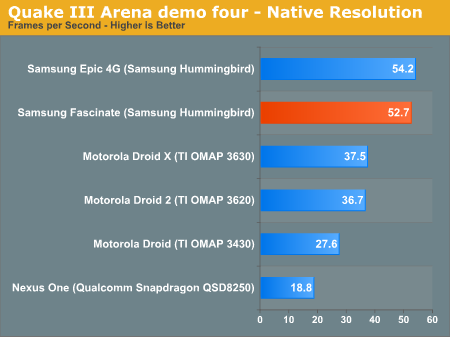
Likewise, we get similarly impressive Neocore numbers out of the Fascinate, which is Qualcomm's benchmark for showing off Adreno.
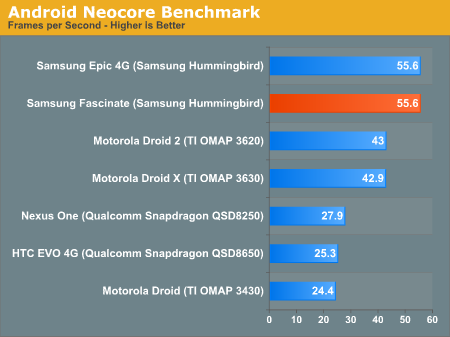
Though most of Android still can't take advantage of the SGX 540, applications that are rendered using OpenGL do show a massive performance boost. The qualitative difference between the stock Android gallery application on the Nexus One compared to the Fascinate is huge. On the Nexus One, it feels occasionally slow and choppy, yet on the Fascinate it's beyond smooth.
When the Android UI finally gets GPU acceleration, that huge performance gain will be readily apparent in everyday use instead of locked away for 3D apps and games.
Of course, our CPU-bound tests show almost exactly what you'd expect from a 1 GHz Cortex-A8. Bear in mind the Fascinate is running Android 2.1 as of these tests, but you can see how much Android 2.2 changes things - in some places.
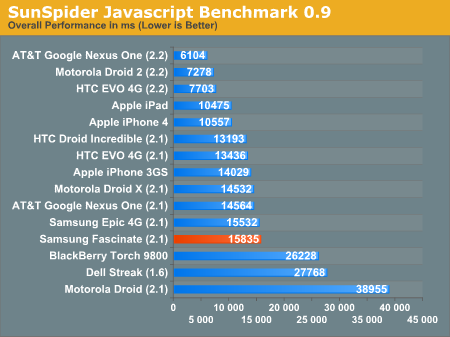

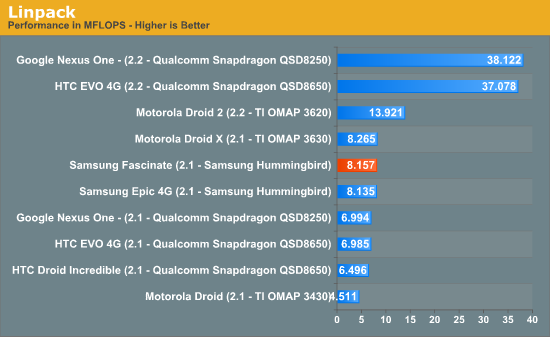
As an aside, I talked in the Droid 2 article about how I didn't quite understand why Linpack performance on Android 2.2 on the OMAP 3620 SoC wasn't what I expected it to be. The comparison I was using was to all the smartphones I had previously seen with Android 2.2 - all of which were Qualcomm Snapdragon SoC based with Scorpion CPUs at the core. The Droid 2 was my first encounter with a relatively standard Cortex-A8 running Android 2.2 with the JIT/NEON optimizations.
As some of our readers noted, the reason that Linpack performance on the Droid 2 isn't as high is simple - Scorpion has faster FPU performance due to a 128 bit SIMD FPU datapath compared to Cortex-A8's 64 bit implementation. Both FPUs process the same SIMD-style instructions, the Scorpion just happens to be able to do twice as much, or optionally turn off half the datapath to save power.
The reason I bring this up is that we won't see as dramatic a change in benchmarks that are FPU/NEON heavy moving from Android 2.1 to 2.2 on the Fascinate. Modest gains are in order all around, but not the dramatic floating point performance boost that really doesn't translate into huge performance gains elsewhere.
I've also been doing the regular suite of page loading tests. Though the Fascinate lacks Flash and the faster browser that 2.2 brings, it renders pretty quickly:
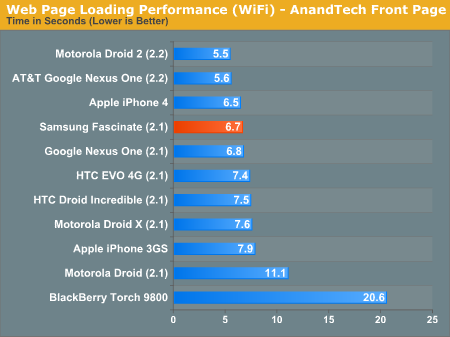
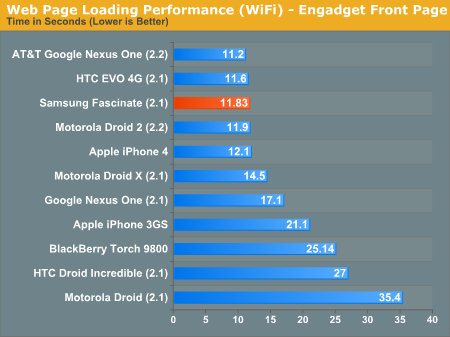










73 Comments
View All Comments
metafor - Tuesday, October 5, 2010 - link
That seems to be a common misconception. Just think about it, the processor is somewhere around ~500mW doing an intensive task. Compare that to an RF radio chip that eats 2W or so while communicating to a 3G cell tower. Or the 2-3W display....The App Processor is a small percentage of overall power draw.
strikeback03 - Tuesday, October 5, 2010 - link
Agreed, checking the power usage utility on Android it isn't uncommon to see the screen drawing the vast majority of the power. Which AMOLED has the potential to help with if there were a way to format websites to be more friendly to it (i.e. no white backgrounds).metafor - Tuesday, October 5, 2010 - link
I'm personally banking on either Pixel Qi or Mirasol improving to the point where they can take over being the displays used. The power savings would warrant any apparent difference in image quality as long as it's "good enough".JimmiG - Wednesday, October 6, 2010 - link
"Just think about it, the processor is somewhere around ~500mW doing an intensive task. Compare that to an RF radio chip that eats 2W or so while communicating to a 3G cell tower. Or the 2-3W display...."I guess you're right. I can play games and watch video on my HTC Desire without using much battery, but 3G browsing absolutely kills battery life. My daily routine involves heavy 3G web browsing on the 1-hour commute to school by train, then the phone spends most of the day in standby, then another hour of heavy usage on the way home in the afternoon. This is enough to run the battery down to ~10% by the time I get home, if I'm lucky enough to have it last the whole day.
But then, how does the iPhone4 manage nearly 7 hours of 3G browsing? Does it use a different radio chip, is it the network, or what?
metafor - Wednesday, October 6, 2010 - link
RF chips don't really vary that much. I would take a guess that it's good software management. What you don't realize is that most of the time you're browsing, you're not actually loading data. You have a burst of data as the website loads, but then it stops.I've noticed on my iPhone that periods of inactivity -- while I'm reading a webpage -- would cause the signal bar to drop a bit. It would go back up once I clicked on a link.
I suspect the software is putting the RF chip in a low-power mode more aggressively than HTC equivalents.
A lot of people discount it but software throttling is the single-most effective way of reducing power consumption.
ssj4Gogeta - Tuesday, October 5, 2010 - link
Is there any chance you'll do an I9000 review? It's the European/Asian version of the Galaxy S. It comes unlocked, doesn't have loads of crap preinstalled, and trades the LED flash for a front VGA cam. It also doesn't have a search button, but you can long-press the menu button to search.Also, please consider trying the voodoo lag fix in your future Galaxy S reviews.
http://project-voodoo.org/
It basically changes the system partition file system from RFS to EXT4, which makes the phone noticeably faster and smoother (no stalling while installing apps, no stuttering..)
8steve8 - Tuesday, October 5, 2010 - link
i personally have an international galaxy s with beta froyo rom (JPK), with lagfix, these are the numbers i get:Rightware BrowserMark:
35345 : my galaxy s 2.2
29018 : fascinate 2.1
sunspider:
07375.8ms : my galaxy s 2.2
15835.0ms : fascinate 2.1
linpack:
14.399 MFLOPS : my galaxy s 2.2
08.157 MFLOPS : fascinate 2.1
NeoCore Benchmark:
55.6FPS : my galaxy s 2.2
55.6FPS : fascinate 2.1
quadrant:
2000ish : my galaxy s 2.2 w/lagfix
0800ish with my galaxy s 2.1 stock
the phone ships with a terrible filesystem setup, causes severe lag over time... as shown in the quadrant score which does some IO stuff... this is fixable with root and a lagfix app...
and gps works about as good as my nexus one
(although in 2.1 builds of the firmware GPS was terrible)
this has been said by everyone, but the 4" SAMOLED displays on these things are sick... makes a nexus one display look really dated, and although props to the iphone for finally getting hi-res, 3.5" just seems comparably too small.
annoying it shipped so broken, but once dealt with, a beautiful device and over-all experience
ssj4Gogeta - Wednesday, October 6, 2010 - link
You don't even require root for voodoo lagfix. It comes in an update.zip and changes the filesystem to ext4.webmastir - Tuesday, October 5, 2010 - link
fantastic review. this is why i love this site! great job & great info.Shadowmaster625 - Tuesday, October 5, 2010 - link
If you can forget that a $500+ piece of hardware is in your pocket, then you need to be... outsourced.